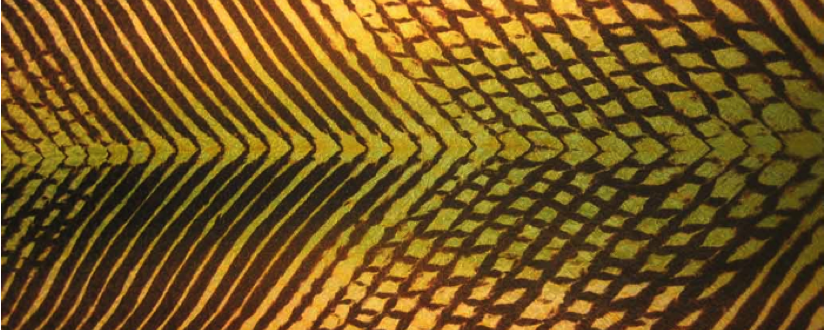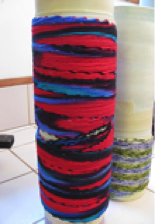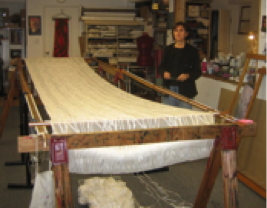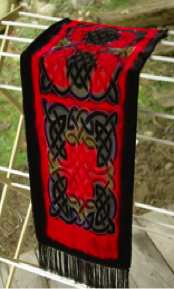
Technique & Care
The Japanese method of shibori resist dyeing allows us to explore the relationship between colour and texture when creating a soft sculpture of wearable art, bringing a contemporary look to this ancient art form.
Taking the silk through various manipulations and dye processes, the designs created are luxurious and unique. Reminiscent of textures found in nature, they remind us of the rocks, tree bark, bird feathers, reptiles, water, vegetation.
ABOUT SHIBORI
Shibori resist dyeing was practiced in countries around the world before the advent of recorded history. In Japan, it was first documented in the Nara period (AD 710 - 794).
A Japanese word meaning to wring or squeeze shibori describes the process by which the designs are created when the fabric is pinched, folded, gathered, knotted, tied or pleated and bound tightly by using string, rope, clamps, needle and thread or other devices to section off parts of the fabric before it is immersed in the dye. These barriers resist the penetration of the dye achieving a layered effect of colour and texture.
ABOUT HANDPAINTING:
The silks are designed and hand painted individually. The fabric is stretched on a free-standing frame and the colours are applied in the form of a liquid dye concentrate using a variety of brushes and sponges. The various colour tones and values are achieved by mixing primary colours. The painted silk is then steamed. This process bonds the dye
with the fibre, making the colour both brilliant and permanent.
Combined with other techniques such as colour discharge, immersion dyeing, wax resist, thickeners, and shibori, interesting and surprising results occur.
ABOUT THE DEVORÉ (burn-out) METHOD
Some of the devoré velvets and satins are done by us in the studio. We silkscreen or hand paint a caustic paste onto the fabric. When dried and heated, this paste burns through the velvet pile, thereby creating a textural pattern on the silk chiffon backing.

The silk bound on the tube

White silk stretched on the frame

Completed devoré velvet scarf
CARE OF YOUR SILKS
The following care instructions are only for silks that we have produced. We cannot recommend these techniques for work that is not from our studio.
Hand Painted Silk Scarves:
Hand wash in cool water using a mild soap, rinse well with a splash of white vinegar in the rinse water. Rinse again. Roll in a towel to sponge. Avoid flattening rolled hems. May also be dry cleaned.
Pleated Shibori Scarves:
Dry clean with solvents only. Absolutely no steaming or pressing. Please discuss this with you dry cleaner.
Your Shibori piece has been hand pleated and set in a hot water bath, then dried on a form in order to create the final texture. It should never again be exposed to water. Please protect it from extreme and prolonged humidity.
Some relaxation will occur as a result of wearing, revealing more of the color and pattern. In the event that it gets wet or should you have an accident we are able to repleat the piece. There is a charge for this service.
To store, roll loosely allowing the pleats to find their natural drape and place in a drawer or box-like container and avoid undo pressure from other garments. Please note that most cardboards, papers and polyethylenes give off acidic vapours that, with prolonged exposure, can contribute to the deterioration of fibers.
For travel, roll or coil into a zip lock bag with a bit of air.
Hand Painted Velvet Scarves:
Use a mild soap or baby shampoo in lots of water without squeezing. Rinse well, gently pressing out the water. Roll it in a towel to sponge. Dry it in the dryer at a low or air fluff setting for a few minutes until mostly dry. This raises the pile of the velvet. Hang it to finish drying.
For fringed scarves: To prevent the fringe from fraying secure it by wrapping with a small sqare of cotton cloth bound with elastic bands. Keep this on during the washing and drying process, then remove, smoothing the fringe and allow to air dry.
Care of “Bubble Silk”:
Hand wash in cool water using a mild soap or shampoo. Rinse well then soak in a fabric softener solution for 15 to 30 minutes (hair conditioner works as well). Tinse again. A splash of white vinegar may be added to the rinse water, Roll in a towel to sponge or spin out in your washing machine (but do not agitate the machin). Hang dry. Never use the dryer because of the 2% lycra content: the elasticity breaks down.